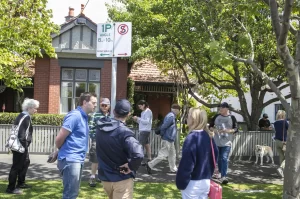With interest rates at record lows, the biggest hurdle in Australia for many aspiring home owners is pulling together the deposit – typically 20 per cent of a property’s market value – that will allow them to get a mortgage in the first place.
One analysis last year estimated it could take first-home buyers up to 15 years to save for a deposit, in which time the market would have risen further.
Several start-ups have seen the potential to make radical changes in the property market by turning their attention to people who want to buy a home but are struggling to save for a deposit.
One of these new property ownership models is ‘rent-to-buy’ or ‘rent-to-own’.
What is a rent-to-buy scheme?
Platforms with rent-to-buy schemes will offer to buy a home that a client rents while also paying an equity contribution.
At the end of an agreed period, the client – who should have built up enough ownership in the home and made a capital gain as well – takes out a standard commercial mortgage and pays out the rent-to-own platform.
Does it exist in Australia?
These schemes are hugely popular in the US, where it is big business. In Australia, it is a relatively new concept and there is only one player in the field so far – OwnHome.
But Commonwealth Bank’s recent investment in this property technology start-up has got people wondering how it all works.
In Australia, concerns about such schemes and their scope for abuse of people who couldn’t get a mortgage because they earned too little, or had a poor credit history, triggered a report in 2016 by the Consumer Action Law Centre in Victoria calling for their banning and the introduction of the same consumer protections that exist around conventional mortgages.
The risk with these schemes is that the consumer doesn’t actually own the dwelling and if they are unable to refinance the property commercially at the end of their agreed period, they lose both the property and the equity they paid.
A platform such as OwnHome argues that mortgages can also leave consumers out of pocket and without a home. It says its hardship provisions that support customers in times of need address the concerns that gave rise to the Victorian regulations.
Can anyone sign up for the scheme?
OwnHome targets higher earners wanting homes in premium metropolitan areas – places where the typical price is well above the $750,000 threshold for government support programs such as the first home loan deposit scheme.
It doesn’t accept customers qualifying for publicly funded schemes.
Hang on, there’s also build-to-rent-to-buy. Is that different?
Very different! OwnHome deals only in the established-home market.
In Victoria, developer Assemble Communities – in which Australian Super has taken a 25 per cent stake – has a separate business model under which the developer builds apartments, such as in inner north-western Melbourne’s Kensington, targeting households in low- to moderate-income bands that people can rent for five years and then buy at the end of that period at an agreed price.
Separately, in Canberra, the National Housing Finance and Investment Corporation, a federal government agency, expects to start a pilot development this year, the Ginninderry joint venture, with Riverview Developments, the ACT government’s Suburban Land Agency and Community Housing Canberra.
Under the model, tenants will pay an affordable rent to the community housing provider with the right to buy the home after 10 years.
NHFIC boss Nathan Del Bon says the Build-to-Rent-to-Buy model offers a way to provide housing to vulnerable groups, such as older women.
“With vulnerable women’s housing needs increasingly in focus, this pilot provides an opportunity to explore affordable pathways to home ownership for at-risk women,” he says.
This article is from Australian Financial Review, please click the following link for the original article: https://www.afr.com/property/residential/rent-to-own-a-home-can-anyone-do-it-in-australia-20220214-p59w70




